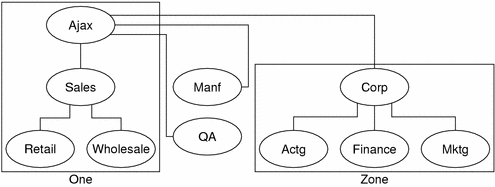Zones and DNS
DNS service for a domain is managed on the set of name servers. Name servers can manage a single domain, multiple domains, or domains with their corresponding subdomains. The part of the namespace controlled by a name server is called a zone. Therefore, the name server is said to be authoritative for the zone. If you are responsible for a particular name server, you might be given the title “Zone Administrator”.
The data in a name server's database are called zone files. One type of zone file stores IP addresses and host names. When someone attempts to connect to a remote host using a host name by a utility like ftp or telnet, DNS performs name-to-address mapping. DNS looks up the host name in the zone file and converts the name into its IP address.
Figure 3–6 Domains and Zones

For example, the Ajax domain in the above example contains a top domain (Ajax), four subdomains, and five sub-subdomains. The domain is divided into four zones. Thus, the Ajax name server administers a zone which is composed of the Ajax, Sales, Retail, and Wholesale domains. The Manf and QA domains are zones unto themselves served by their own name servers. The Corp name server manages a zone composed of the Corp, Actg, Finance, and Mktg domains.
Reverse Mapping
The DNS database also includes zone files that use the IP address to find machine host names, enabling IP address to host name resolution. This process is called reverse resolution or more commonly, reverse mapping. Reverse mapping is used primarily to verify the identity of the machine that sent a message or to authorize remote operations on a local host.
The in-addr.arpa Domain
The in-addr.arpa domain is a conceptual part of the DNS namespace that uses IP addresses for its leaves, rather than domain names. The domain is the part of your zone that enables address-to-name mapping.
in-addr.arpa domain IP addresses are read from lowest level to the root. Thus, the IP addresses are read backward. For example, suppose a host has the IP address 192.168.21.165. In the in-addr.arpa zone files, its address is listed as 165.21.168.192.in-addr.arpa. with the dot at the end indicating the root of the in-addr.arpa domain.
- © 2010, Oracle Corporation and/or its affiliates
